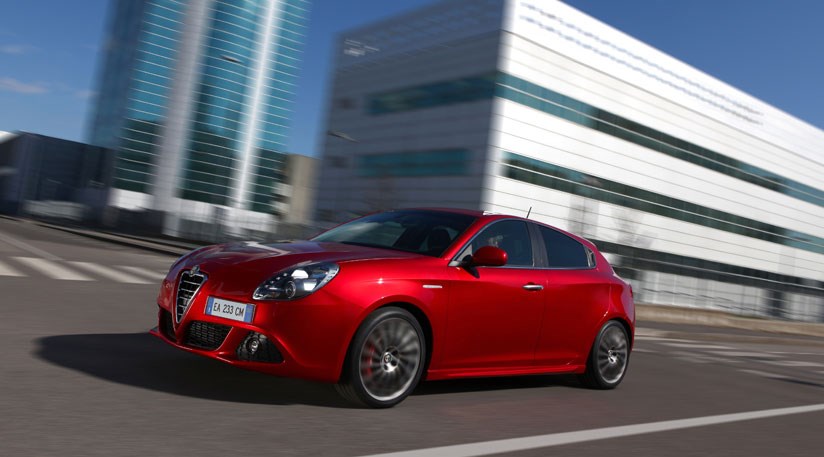Alfa Romeo Giulietta 1.4 TB 170

Alfa Romeo is launching the new 2010 Giulietta to replace its 147 in the heartland mid-sized hatch. So the new Alfa Giulietta faces up to some pretty competent machinery, such as the VW Golf, Ford Focus and Vauxhall Astra.
What’s going on? I thought Alfas were meant to look great and be terrible to drive. Let’s hope this one drives better than it looks...
We assume you’re talking about the Giulietta's less than beautiful face on this new C-segment fighter. Granted, it’s bland and formless after the chiselled muscularity of the old 147, but we’ve got modern pedestrian crash legislation to thank for that. The Giulietta's snout is a grower anyway and the rest of the shape makes up for it. The chunky hind quarters mean you need to move up from the basic 16in rims but the rear three-quarter view is swoopingly fantastic to these eyes.
The new 2010 Giulietta looks much bigger than the old 147
It is, but that’s because Alfa has replaced the 147 with two cars: the smaller three-door Mito and the five-door-only Giulietta.
The big hatch is fractionally bigger than a Golf with a generous 350-litre boot and a back seat that doesn’t quite offer best in class accommodation (the squab is too low and kneeroom only average) but is at least competitive.
So what’s underneath the new Giulietta? A Fiat Bravo chassis? Hardly going to battle for top honours with that arsenal!
That’s why Alfa left it in the parts bin, instead developing an all-new lightweight steel platform that will underpin the next wave of Alfa Romeos – plus the next Fiat Bravo. Using high-strength steel means the finished car weighs 1365kg, little more than the smaller 147 and much less than Vauxhall’s porky Astra. It bodes well...
But is the Giulietta any good?
Oh yes. For a start the Giullietta rides with a suppleness that’s been sorely lacking in recent Alfas, even on our optioned-out test car with its sportier dampers and 17in wheels. It steers crisply too thanks to a new fully electric twin pinion steering rack whose motor is mounted away from the steering column to minimise artificial sensations through the rim.
With just 2.2 turns between the stops it’s fast but never nervous around the straight ahead and with a realistic build-up of weight as the cornering speeds rise. And they really can rise: the Q2 electronic differential standard on every single model provides a staggering amount of traction, even on rain-drenched tarmac and the body control on our sport-equipped car was good.
What’s going on? I thought Alfas were meant to look great and be terrible to drive. Let’s hope this one drives better than it looks...
We assume you’re talking about the Giulietta's less than beautiful face on this new C-segment fighter. Granted, it’s bland and formless after the chiselled muscularity of the old 147, but we’ve got modern pedestrian crash legislation to thank for that. The Giulietta's snout is a grower anyway and the rest of the shape makes up for it. The chunky hind quarters mean you need to move up from the basic 16in rims but the rear three-quarter view is swoopingly fantastic to these eyes.
The new 2010 Giulietta looks much bigger than the old 147
It is, but that’s because Alfa has replaced the 147 with two cars: the smaller three-door Mito and the five-door-only Giulietta.
The big hatch is fractionally bigger than a Golf with a generous 350-litre boot and a back seat that doesn’t quite offer best in class accommodation (the squab is too low and kneeroom only average) but is at least competitive.
So what’s underneath the new Giulietta? A Fiat Bravo chassis? Hardly going to battle for top honours with that arsenal!
That’s why Alfa left it in the parts bin, instead developing an all-new lightweight steel platform that will underpin the next wave of Alfa Romeos – plus the next Fiat Bravo. Using high-strength steel means the finished car weighs 1365kg, little more than the smaller 147 and much less than Vauxhall’s porky Astra. It bodes well...
But is the Giulietta any good?
Oh yes. For a start the Giullietta rides with a suppleness that’s been sorely lacking in recent Alfas, even on our optioned-out test car with its sportier dampers and 17in wheels. It steers crisply too thanks to a new fully electric twin pinion steering rack whose motor is mounted away from the steering column to minimise artificial sensations through the rim.
With just 2.2 turns between the stops it’s fast but never nervous around the straight ahead and with a realistic build-up of weight as the cornering speeds rise. And they really can rise: the Q2 electronic differential standard on every single model provides a staggering amount of traction, even on rain-drenched tarmac and the body control on our sport-equipped car was good.
0 comments:
Post a Comment